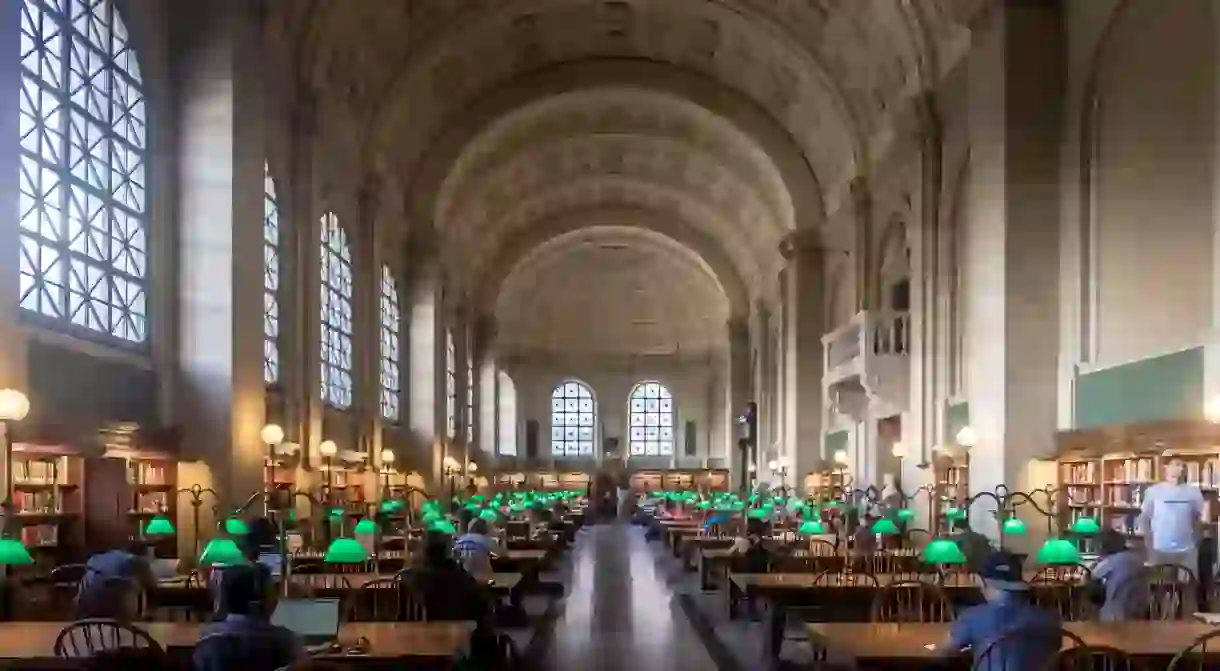The Most Beautiful Libraries in America

The United States is home to thousands of public, private and university-owned libraries – and they’re each beautiful in their own way. We’ve drilled down 10 of the best examples of great architectural styles, from neoclassical to brutalist.
Did you know – Culture Trip now does bookable, small-group trips? Pick from authentic, immersive Epic Trips, compact and action-packed Mini Trips and sparkling, expansive Sailing Trips.
Beinecke Rare Book and Manuscript Library

The Beinecke Rare Book and Manuscript Library is Yale University’s principal source of literary archives, early manuscripts and rare books, and it’s used by students and researchers around the world. Designed by architect Gordon Bunshaft of Skidmore, Owings & Merrill with the goal of filtering daylight to protect the books, the building was completed in 1963 and constructed out of marble and granite sourced from Vermont. This unique geometric exterior stands in juxtaposition to the neoclassical and neogothic architecture in the university courtyard.
The Boston Public Library

The Boston Public Library, which opened in 1854, was the first free public library in the United States. Its design has evolved over the years, with architect Charles Follen McKim completing his palace for the people in the present Copley Square location in 1895, before architect Philip Johnson designed an addition in 1972. The library is considered an example of great American beaux-arts classicism – and, indeed, it became a national historic landmark in 1986. Inside the building are murals, collections of rare books, prints, manuscripts and maps, as well as gallery space.
George Peabody Library

A division of the Johns Hopkins University, the George Peabody Library opened in 1878 as part of the Peabody Institute – a free public library, with lecture series, music conservatory and art collection dedicated to the citizens of Baltimore. The library was designed by local architect Edmund George Lind in collaboration with the institute’s first director, Dr Nathaniel H Morison – and it’s widely known for its dramatic interior, characterized by soaring ceilings and five stories of intricate cast-iron balconies.
Hearst Castle

Located on the central coast of California, Hearst Castle was once the private residence of newspaper mogul William Randolph Hearst and designed by the prolific California-based architect Julia Morgan. Building work started in 1919, and it is now both a National and California Historic Landmark. It was built to reflect the European styles of architecture that Hearst so admired, and it displays his large collection of art, books and antiques. The 80ft (24m) library holds approximately 4,000 books, while the study houses his collection of medieval texts, paintings, statues and textiles.
Library of Congress

Founded in 1800, the Library of Congress is the oldest federal cultural institution in America. Its original building, which stood until 1814 before it was destroyed by British troops, was commissioned by the second president of the United States, John Adams. His successor, Thomas Jefferson, then offered his personal library – equipped with some of America’s most valuable literary pieces in his possession – and this served as the foundation for the Library of Congress that we see today. The interior of the beaux-arts building features marble, bronze, gold and mahogany; more than 50 American artists contributed to the hand-carved sculptural and painted decorations.
Los Angeles Central Library

The Los Angeles Central Library is the largest public library in the west of the United States. Built in 1926 by Bertram Goodhue, it takes design cues from ancient ziggurat structure, with geometric and symbolic motifs throughout the building. On top of the library is a distinctive, tiled pyramid with a golden hand holding a torch, while the interior features works in various mediums by a range of artists, including the main lobby’s intricately painted ceiling by Renee Petropoulos.
New York Public Library

The Stephen A Schwarzman Building serves as the main branch of the New York Public Library, a beaux-arts landmark building next to Bryant Park on Fifth Avenue and 42nd street in Manhattan. Construction began in 1902 after architecture firm Carrère & Hastings won the library’s design competition. It cost a cool $9m to complete, and opened in 1911 to between 30,000 and 50,000 visitors. The building houses a comprehensive collection of historical items, from medieval manuscripts and ancient Japanese scrolls to baseball cards and comic books.
The Morgan Library and Museum

Financier JP Morgan possessed boasted a comprehensive collection of art – from rare books and prints to ancient artefacts. In 1924, his son, JP Morgan Jr, donated his father’s library to the public and the Morgan Library & Museum was born. Located on Madison Avenue and 36th street in Manhattan, this extraordinary structure was built between 1902 and 1906 by Charles Follen McKim, and it occupies half the city block. Since 1924, several additions have been added to house a growing collection, including an annex in 1928, a brownstone in 1988 and an outdoor garden in 1991. Led by Renzo Piano, in 2006 the building underwent its most extensive renovation yet to improve visitor accessibility as well as gallery and archival space.
Seattle Public Library

In 1998, Seattle voted to improve all 22 branches of the Seattle Public Library. The location of the central library stayed the same, but was completely redeveloped by architect visionaries Rem Koolhaas and Joshua Prince-Ramus. Following the principle that form follows function, they created an accessible design that celebrates literature. Working closely with the public as well as the library board and staff, Koolhaas and Prince-Ramus revamped the entire library building, adding space and improving function. These days, the library houses over 1m items with an improved digital archive and more than 400 computers.
The Geisel Library

The University of California San Diego’s Geisel Library is a brilliant brutalist build designed by William L Pereira & Associates. This striking building primarily features concrete and glass, and looks right at home on the university’s modernist campus. From from 110ft (33.5m) at the tower’s apex, students can enjoy outstanding panoramic views of the campus.













